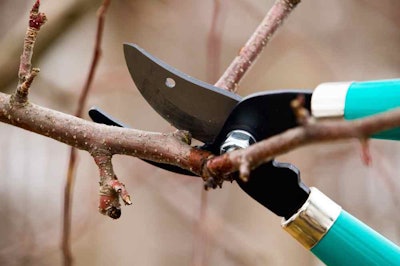
Tree trimming is part art and part science. Don’t assume you can go in with loppers and a chainsaw and fake your way through it. Pruning a tree requires proper technique and a good understanding of how trees grow. Otherwise, your pruning mistakes will be evident to everyone come spring.
The following tips can get you started trimming trees. If you need more information, the International Society of Arboriculture has developed extensive standards for proper tree pruning. You can find their guide on this site.
Tree health is paramount in the trimming process
Routine pruning isn’t about lopping limbs to transform a tree into an unnatural shape. It’s about maintaining a tree’s health: removing limbs that are weak, diseased or dead. Even then, proper pruning seldom requires removing more than 1/4 inch of a branch’s crown. Removing any more than 1/4 inch can alter the tree’s ability to make food, which hampers its overall health and hinders its growth potential. You should cut any low-hanging limbs that impede pathways or are making contact with buildings or other structures. But don’t go crazy. Remember, the principal philosophy here is that no branch should be removed without a reason.
Basic trimming techniques
According to the ISA, there are four specific types of pruning that may be necessary to maintain a mature tree in a healthy, safe and attractive condition:
- Cleaning is the removal of dead, dying, diseased, crowded, weakly attached and low-vigor branches from the crown of a tree.
- Thinning is the selective removal of branches to increase light penetration and air movement through the crown. Thinning opens the foliage of a tree, reduces weight on heavy limbs, and helps retain the tree’s natural shape.
- Raising removes the lower branches from a tree in order to provide clearance for buildings, vehicles, pedestrians and vistas.
- Reduction reduces the size of a tree, often for clearance for utility lines. Reducing the height or spread of a tree is best accomplished by pruning back the leaders and branch terminals to lateral branches that are large enough to assume the terminal roles (at least 1/3 the diameter of the cut stem). Compared to topping, reduction helps maintain the form and structural integrity of the tree.
Decide which type of pruning applies to your client’s tree and plan cuts before gearing up. Make pruning cuts just outside the branch collar, which should be left intact to avoid trunk damage. The ISA says how much you prune from a tree depends on the size of the tree and its age. The younger the tree, the more you can cut. A tree can recover from several small pruning wounds faster than from one large wound. And mature trees become less tolerant of pruning altogether. Try to limit the pruning of older trees to the removal of dead or hazardous limbs only.
If you’re removing a larger limb, reduce its weight by removing it piece by piece. To do this, cut about a third of the way upward through the limb, sawing from the bottom up (which will help prevent the bark from stripping). Then cut through the branch from the top, just beyond the previous undercut. When you’re down to the stub, remove it by cutting it back to the branch collar.
Once you’ve finished your pruning, you might be tempted to add a wound dressing to the tree to protect against the possibility of disease and decay. However, the ISA reports that most experts advise against this because research indicates that wound dressings do not prevent it either.
Safety first
While your tree trimming efforts may involve the use of only a handsaw or lopper, sooner or later you’re likely to encounter pruning that requires a chainsaw. If so, proper training and instruction are essential. I’m not suggesting that it’s a good idea; I’m saying it should be mandatory in your company. Yes, it’s an investment of time and money, but the payback is safer, healthier, more productive crews. To find a chain saw safety class in your area, contact your chain saw dealer or county extension agent.
Safety apparel is another essential element for tree pruning with a chainsaw. This should include chaps or pants to protect your legs, cut-resistant boots, a helmet, hearing and eye protection as well as cut-resistant gloves.
Once you arrive at a job, begin by evaluating the area. Before you begin pruning, look for power lines in close proximity to the trees you’ll be working on. If the limb is anywhere near a power line, immediately contact the utility company or other professionals experienced with this type of risky job.
Also check to see if falling limbs could be a danger to bystanders, vehicles or other property. You need to have enough room to work, so rope off the space you need to prevent spectators from coming too close. Also, walk around the tree to locate any weird angles or low spots in the ground that could affect your footing. And always make sure that you have an escape route clear of tools and debris.
If you need to remove a branch high up in the tree and don’t have experience with rope and harness climbing, get a professional arborist to do the job for you. It’s not worth the risk without additional safety equipment and training. Again, your county extension agent can provide you with information on rope and harness training courses.









